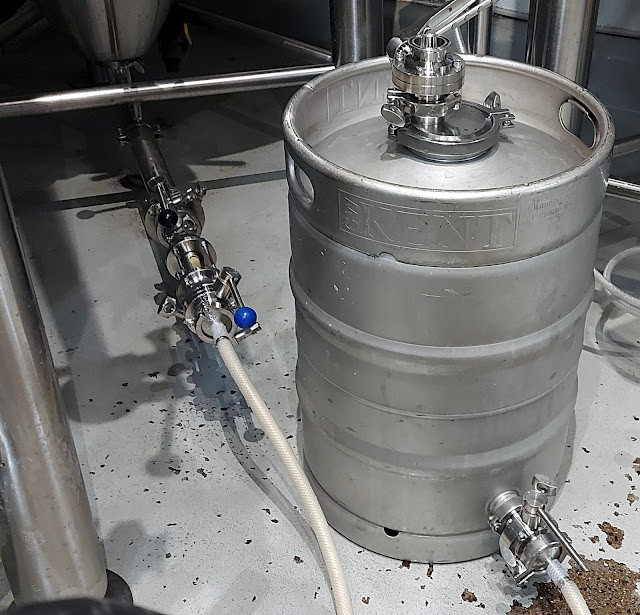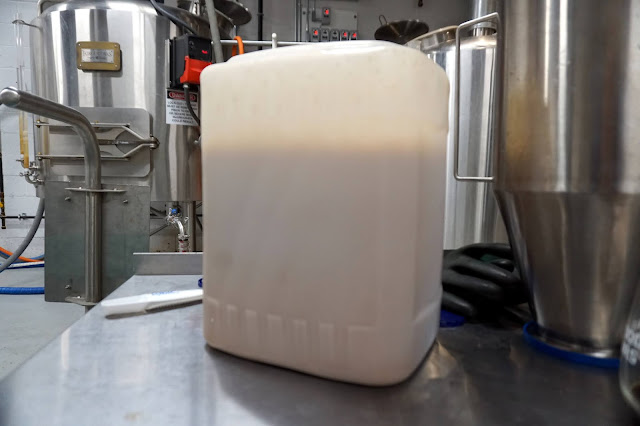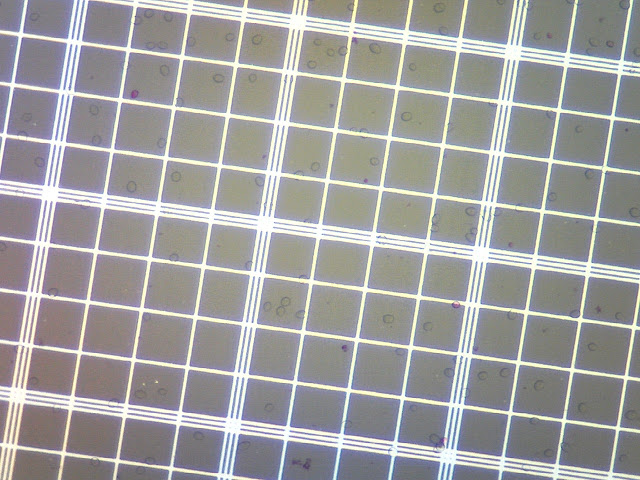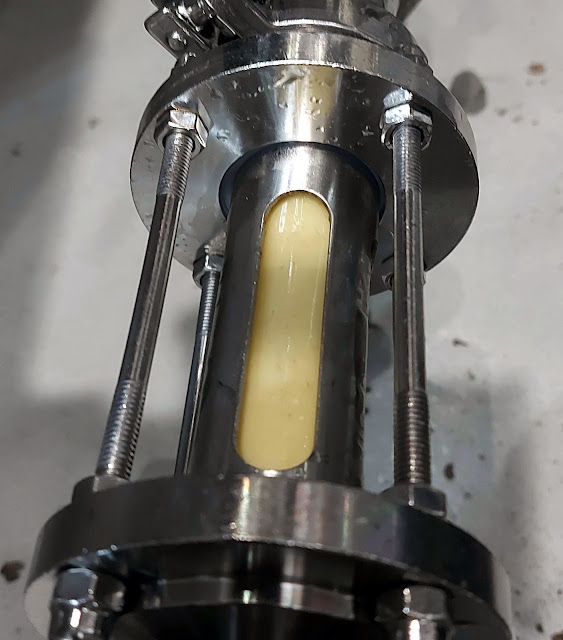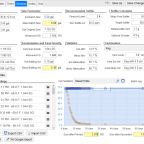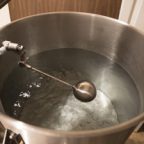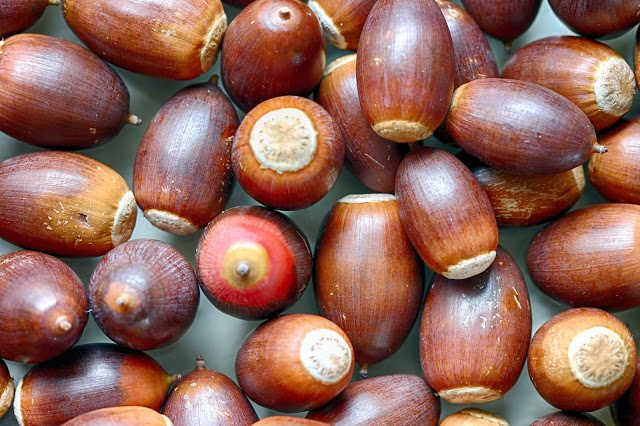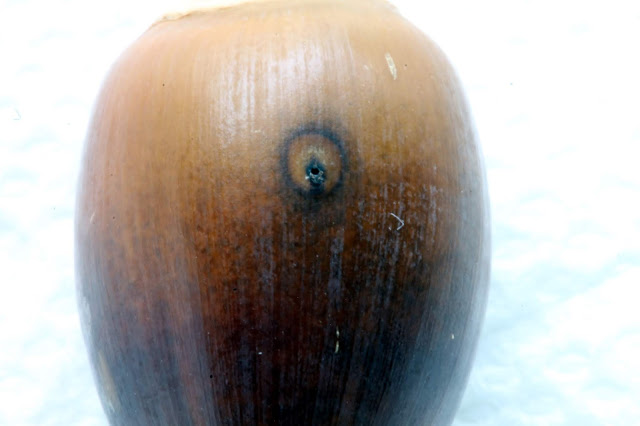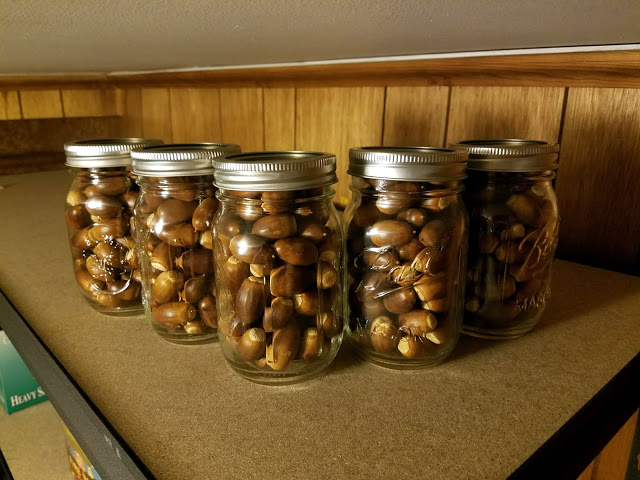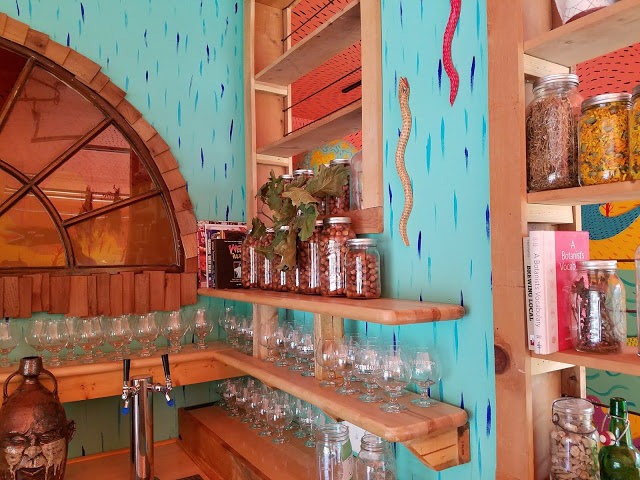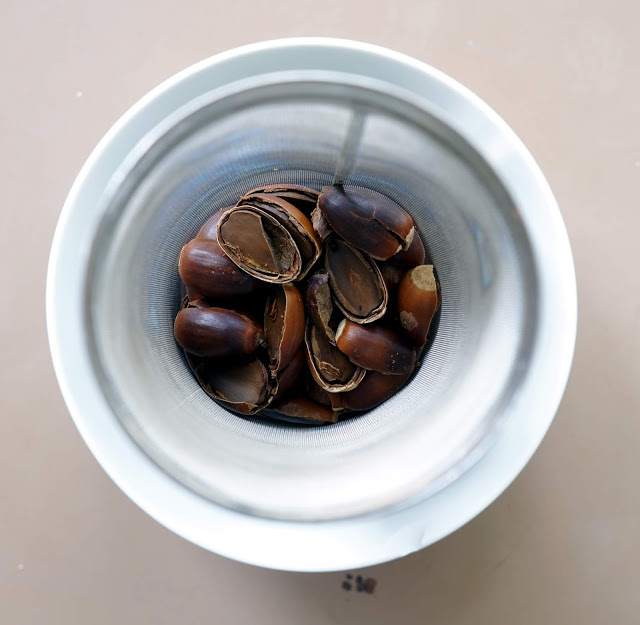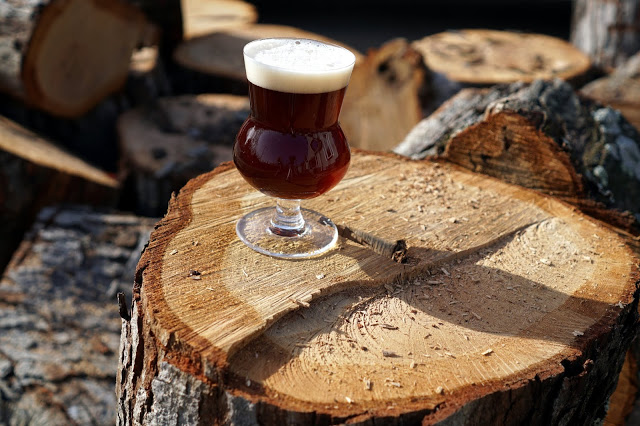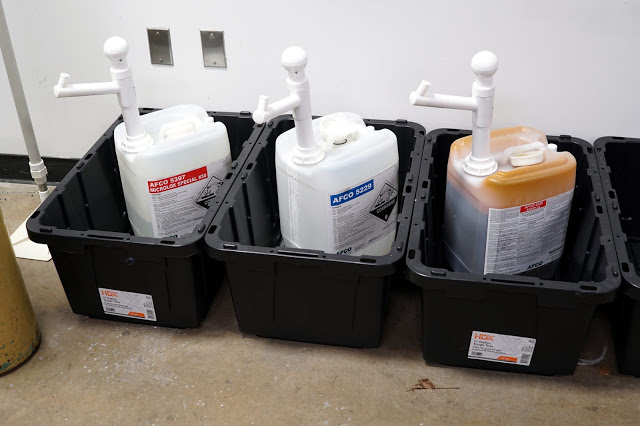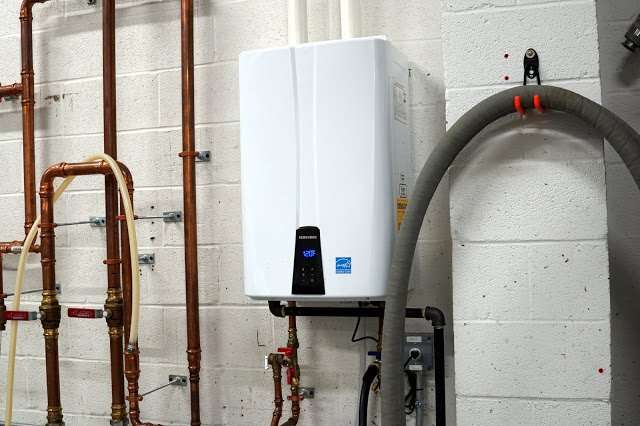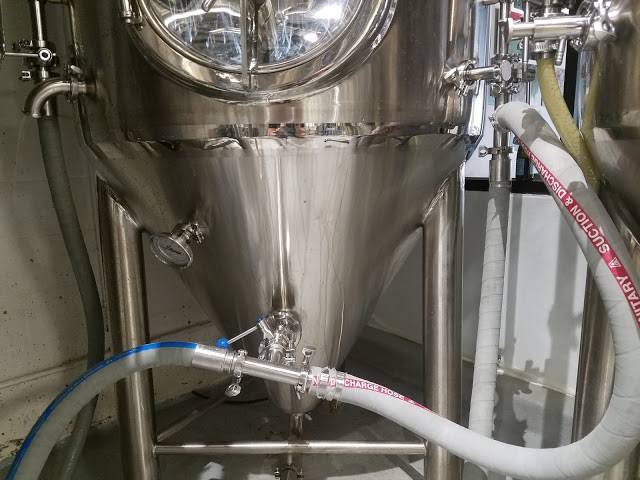pH
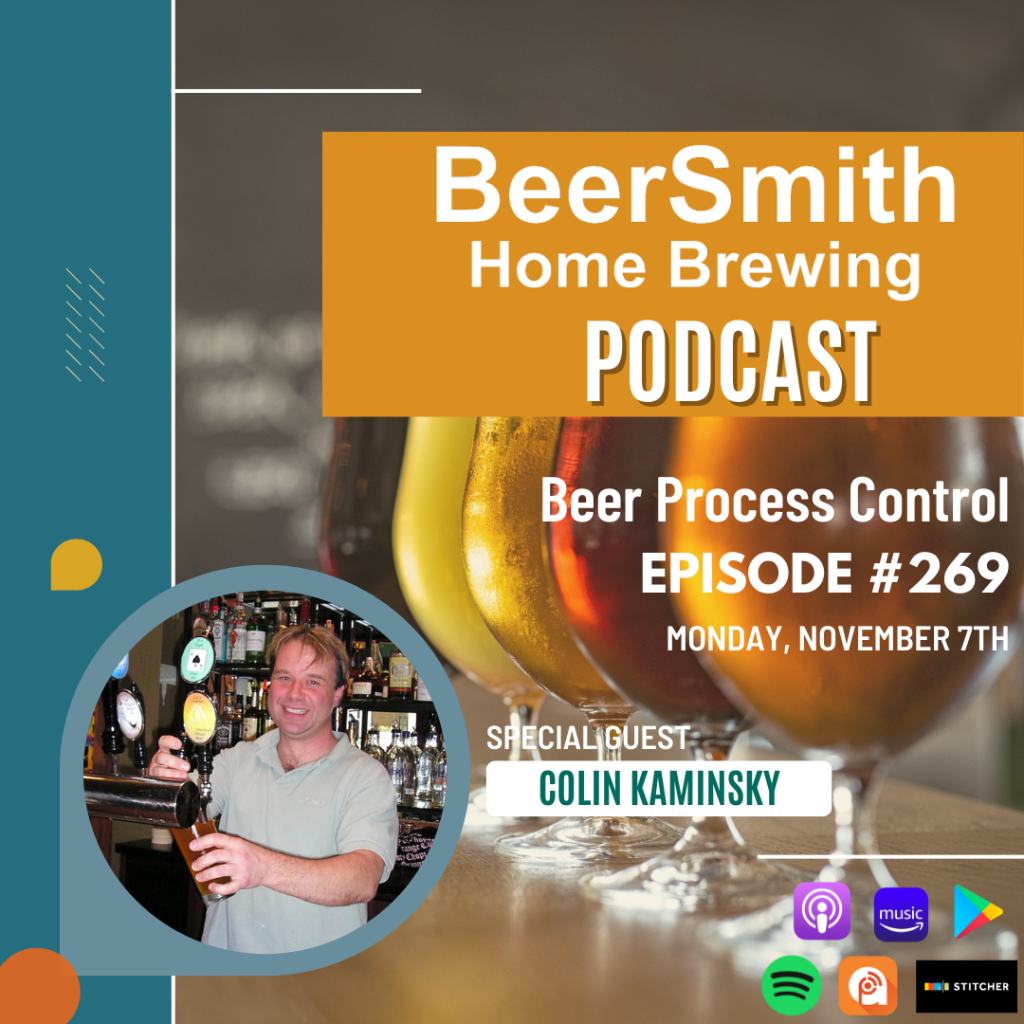 Colin Kaminski joins me this week to discuss his experiences with professional brewing process control and how it applies to the home brewer. Subscribe on iTunes to Audio version or Video version or Spotify or Google Play Download the MP3 File– Right Click and Save As to download this mp3 file. Your browser does not […]
Colin Kaminski joins me this week to discuss his experiences with professional brewing process control and how it applies to the home brewer. Subscribe on iTunes to Audio version or Video version or Spotify or Google Play Download the MP3 File– Right Click and Save As to download this mp3 file. Your browser does not […] When it comes to brewing delicious beer, there are few aspects more important than the yeast. A healthy fermentation allows the malt, hops, and adjuncts to shine. Pitching the right amount of healthy cells helps ensure that the finished beer has the intended alcohol, expected residual sweetness, and appropriate yeast character.
Over the last four years at Sapwood Cellars we've slowly improved our yeast handling. We've noticed improved fermentation consistency, and better tasting beers. Most of our process is excessive for a homebrewer, but it might give you some ideas!
Harvesting Yeast
We harvest yeast from moderate gravity beers when possible as these cells are less stressed and healthier as a result. Our general rhythm is to brew a pale ale with a fresh pitch, and harvest from that tank for an IPA and DIPA the following week. Once the pale ale fermentation is complete (repeated gravity readings, and no diacetyl or acetaldehyde sensory) we can and soft-crash to 56-58F (13-14C). Cold and dissolved CO2 encourage the yeast to settle out. Specific temperature and time are strain and tank dependent, but that works for most of the English-leaning strains we use (Boddington's, Conan, Whitbread, and the Thiolized-variants).
Once the beer has been cold for 24 hours, we attach a 1/2 bbl brink to the bottom of the tank and pasteurize through the line and brink with 180F (82C) water from our on-demand. 25 minutes hot ensures there aren't any stray microbes that will be passed onto the subsequent batches. After pushing out the water with CO2 pressure we spray the brink with cold water then pressurize it and the tank to ~10 PSI.
We then dump about a gallon (4L) from the T until the yeast looks good (creamy, off-white) and then begin collecting into the brink. You don't need to dump a large volume of yeast. By keeping steady pressure on the tank and slowly releasing pressure on the brink through the valve at the top we ensure that the yeast won't come out of the cone too quickly (which could punch through pulling in more beer than yeast) and won't foam up in the brink. It takes 10-15 minutes to fill the brink. Usually we are able to collect 110-130 lbs (50-60 kg) before yeast starts coming out the top of the brink.
We collect yeast before dry hopping to avoid having hops mixed in with the yeast. We also prefer the "less rough" flavor we achieve by dry hopping cold. If you dry hop early-mid fermentation and want to harvest, drop as much of the hops out as you can before crashing and harvesting.
Yeast Storage
Whenever possible we pitch within 72 hours of harvest. Larger yeast cultures generate more heat and thus tend to lose viability more rapidly. Store the yeast as cold as possible, which for us is ~36F (2C) in our walk-in. Ideally that would be closer to 32F (0C) to further slow its metabolism. Shake twice a day to dissipate hot-spots and vent down the pressure to knock-out CO2. If storing the yeast for more than a few days, attach a blow-off line to prevent pressure from building.
There are studies about various additives for maintaining high yeast viability. We've added phosphate buffer to prevent a drastic pH drop. It's difficult to tell from a single data point, but viability dropped from 95% to 89% after a week of storage. We've seen closer to 10% reductions the handful of times we've stored yeast that long previously.
We generally won't harvest and repitch beyond three generations (although recently we went to five). That's because with our limited number of tanks, variety of yeast strains, and canning schedule we'd eventually have to hold onto yeast for a couple of weeks before pitching or harvest from a strong beer.
Determining Cell Count and Viability
There are plenty of successful brewers who pitch a standard weight by barrel/gravity, but knowing how many live cells you actually have is a great way to improve consistency. It's especially valuable if you use a variety of strains or want to bring in a new strain. Our harvests of the same strain can vary by as much as three times in terms of live cells per g of slurry (~.5-1.5 billion cells). The cost of all of the equipment required is ~$500, less than a single commercial 10 bbl yeast pitch from some labs.
Start by shaking the brink to homogenize the culture. Then run a cup of yeast out, dump it (to avoid counting the cells packed around the port) and then pull a sample. The next step is to dilute the culture to a "workable" concentration - 1:100 for us. Too many cells packed together makes for a culture that is impossible/laborious to count, while too few raises the chances luck will throw-off the count. For a long time I diluted by volume, performing two sequential 10X dilutions with a micropipette. This had two drawbacks. First getting an accurate volume of yeast slurry is tricky because it is foamy and has small bits of trub that can plug-up the pipette. Second, we pitch by weight, so there was always some estimation when it came to converting the volume to a weight or the extra step of determining the physical density of the slurry by mixing with water in a graduated cylinder on a scale. What we do now is dilute by weight, which gives us cells per gram rather than cells per milliliter.
Our scale is accurate to .2 g, so weighing 1 g of yeast into 99 g of water has a ~20% margin of error. As a result I do 490 g of water with 5 g of the yeast slurry. This reduces the maximum margin of error to ~4%. After pouring the diluted culture back and forth to mix, I take 9.9 mL of the diluted culture with the micropipette and add .1 mL of a stock dye solution of Erythrosin B and phosphate buffer (1 g in 50mL of buffer). This results in a total dilution of 100X. You could go even further, a 10X dilution by weight (50 g yeast with 450 g of water) followed by a 10X dilution by volume (1 mL of the diluted culture with 8.9 mL water and .1 g of dye). Live cells are able to expel the Erythrosin B so they won't be stained, meaning any red yeast cells are dead. You can use a variety of other stains, but Erythrosin B is a food coloring and much safer to handle than methylene blue or trypan blue. Here's a post from Escarpmant Labs on using it inspired by my Tweet (which was in turn inspired by this).
Luckily the Boddingtons-type strain we use for most of our batches isn't "excessively" flocculent. When we fermented a run with Whitbread we ran into issues with the cells being too clumpy to count. Luckily BrewKaiser has a whole post on additions you can add to help. Phosphoric acid worked OK, but a local brewer suggested disodium EDTA, which I plan to buy before we do another run with a similar strain.
Next, place a couple drops on the diluted culture a hemocytometer, apply the slide cover, and stick it under a microscope (we have an Omax). Count the live and dead cells in five squares (each made up of 25 small squares) - four corners, and center. This provides a large enough sample size to avoid undue randomness. A small tally counter helps keep track. The standard rule is to count cells touching the left and top lines, but not the right or bottom. Count connected cells as two only if the daughter cell is more than half the size of the mother. Then I plug the totals into Inland Island's Yeast Cell Count Calculator. Usually our harvests are 80-90% viable off a fresh pitch, and they tend to go up from there on subsequent generations (90-95%). If your viability isn't great it could either be that the yeast isn't getting enough nutrients/oxygen, your initial pitching rate was too high or low, or that you are waiting too long to harvest.
There are automated solutions for yeast counting, but with some practice the whole processes will take less than 10 minutes.
Pitching YeastTo pitch, we attach the brink to a T inline during knock-out. With the brink on a scale we use CO2 to slowly push in the desired weight of yeast (calculated based on the cell count, wort gravity, and volume). We pitch during knock-out so the yeast mixes with the aerated wort as it goes into the fermentor. White Labs advocates using a pump to pitch their fresh yeast inline to achieve better mixing with the wort. Best practice is to do another cell count off the tank once knock-out is complete to validate your process (we did it a few times, but now trust our approach).
When we started brewing more double batches to fill our 20 bbl tanks, we were pitching enough cells for 20 bbls along with the first 10 bbls of wort. Our thought process was that the yeast wouldn't do much in the 3-4 hours before the second half of the wort went in. However, we found our fermentations were less reliable, often dragging towards terminal gravity, and the yeast from those batches had much lower viability than expected. Both of these issues improved significantly once we switched to pitching only enough cells for the initial knock-out volume. This allows for more growth and thus a higher proportion of younger yeast cells.
Hopefully this overview of our process is helpful for someone starting a new craft brewery, or looking to take their yeast management to the next level. As with anything in brewing, the more variables you can track and control the more consistency you'll have in your results. Yeast management isn't a "fun" topic, but it is one of the simplest things a brewery can do to increase consistency, improve flavor, and save money!
 This week I take a look at the technical nature of beer brewing and how it differs from making other beverages like wine, cider or mead. Beer Brewing and Technology I often open my designing beer presentations with a description of the technical nature of brewing. Beer brewing is a much more technical hobby than […]
This week I take a look at the technical nature of beer brewing and how it differs from making other beverages like wine, cider or mead. Beer Brewing and Technology I often open my designing beer presentations with a description of the technical nature of brewing. Beer brewing is a much more technical hobby than […]  This week I’m going to cover the two major methods (in two parts) used to create sour beers at a home brew level. While sour beer brewing is considered a more advanced brewing technique, it is possible for even a beginning homebrewer to create great sour beers using these methods. Sour Beer Basics Sour beers […]
This week I’m going to cover the two major methods (in two parts) used to create sour beers at a home brew level. While sour beer brewing is considered a more advanced brewing technique, it is possible for even a beginning homebrewer to create great sour beers using these methods. Sour Beer Basics Sour beers […] 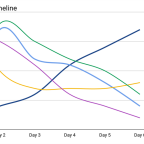 This week I take a look at how yeast ferments wort into beer by looking at a simple graph from White Labs on the fermentation timeline. Fermentation Over Time Most of us know the basics of fermentation where yeast consumes simple sugars from the wort, chiefly maltose, and converts them into alcohol, carbon dioxide gas […]
This week I take a look at how yeast ferments wort into beer by looking at a simple graph from White Labs on the fermentation timeline. Fermentation Over Time Most of us know the basics of fermentation where yeast consumes simple sugars from the wort, chiefly maltose, and converts them into alcohol, carbon dioxide gas […]  BeerSmith Holiday Sale – 20% Off!Get the lowest price we’ve ever offered on a combined BeerSmith desktop and BeerSmith web Gold license starting at $11.95 for your first year! (Sale ends at midnight Eastern US time on Monday 6 December) Imagine Your Best Beer Ever!Take the guesswork out of your brewing. BeerSmith desktop and BeerSmith […]
BeerSmith Holiday Sale – 20% Off!Get the lowest price we’ve ever offered on a combined BeerSmith desktop and BeerSmith web Gold license starting at $11.95 for your first year! (Sale ends at midnight Eastern US time on Monday 6 December) Imagine Your Best Beer Ever!Take the guesswork out of your brewing. BeerSmith desktop and BeerSmith […]  This week I take a look at the differences between alpha and beta amylase which act during the mash to convert longer starch chains to simple sugars in beer. Alpha vs Beta Amylase Enzymes are naturally produced in malted barley during the malting process. Chief among these are alpha amylase and beta amylase. They are […]
This week I take a look at the differences between alpha and beta amylase which act during the mash to convert longer starch chains to simple sugars in beer. Alpha vs Beta Amylase Enzymes are naturally produced in malted barley during the malting process. Chief among these are alpha amylase and beta amylase. They are […] Learn how to brew better kettle sours then make your own at home with this all grain recipe.
The post All Grain Recipe: Zilwaukee Bridge Bruin appeared first on Beer & Brewer.
 Jamil Zainasheff, founder of Heretic Brewing joins me this week for a beer brewing question and answer session. I apologize for the audio quality – we had some echo coming through from Jamil’s audio feed. Subscribe on iTunes to Audio version or Video version or Spotify or Google Play Download the MP3 File– Right Click […]
Jamil Zainasheff, founder of Heretic Brewing joins me this week for a beer brewing question and answer session. I apologize for the audio quality – we had some echo coming through from Jamil’s audio feed. Subscribe on iTunes to Audio version or Video version or Spotify or Google Play Download the MP3 File– Right Click […]  An overview of the mash tab in the beer recipe builder for BeerSmith Web as well as a short introduction on how to calculate and make mash pH adjustments. Related Videos: Design Tab | Yeast Starter Tab | Water Profile Tab | Timer Tab | Session Tab | Recipe Adjustment Tools | Find/Scale Recipes | […]
An overview of the mash tab in the beer recipe builder for BeerSmith Web as well as a short introduction on how to calculate and make mash pH adjustments. Related Videos: Design Tab | Yeast Starter Tab | Water Profile Tab | Timer Tab | Session Tab | Recipe Adjustment Tools | Find/Scale Recipes | […]  John Palmer joins me this week to discuss adjusting your water for beer brewing including mash pH and also improving the flavor of your beer. Subscribe on iTunes to Audio version or Video version or Spotify or Google Play Download the MP3 File– Right Click and Save As to download this mp3 file. Your browser […]
John Palmer joins me this week to discuss adjusting your water for beer brewing including mash pH and also improving the flavor of your beer. Subscribe on iTunes to Audio version or Video version or Spotify or Google Play Download the MP3 File– Right Click and Save As to download this mp3 file. Your browser […]  This week I take a look at homebrewing in the modern era, how it has developed and the impact of technology on brewing. A Quick History of Modern Homebrewing While brewing beer at home has been done for many thousands of years, the modern history of homebrewing in the US has some clearly defined dates: […]
This week I take a look at homebrewing in the modern era, how it has developed and the impact of technology on brewing. A Quick History of Modern Homebrewing While brewing beer at home has been done for many thousands of years, the modern history of homebrewing in the US has some clearly defined dates: […]  I’m pleased to announce the release of a web based version of BeerSmith 3 along with a desktop BeerSmith 3.2 update. The web based version allows you to edit your cloud based recipes from anywhere by simply logging into your cloud account at BeerSmithRecipes.com. BeerSmith Web Highlights Web based recipe editing from any browser by […]
I’m pleased to announce the release of a web based version of BeerSmith 3 along with a desktop BeerSmith 3.2 update. The web based version allows you to edit your cloud based recipes from anywhere by simply logging into your cloud account at BeerSmithRecipes.com. BeerSmith Web Highlights Web based recipe editing from any browser by […] American craft beers find their way into Japanese and Korean restaurants.
The post Spice, Fat, Acid, Beer appeared first on CraftBeer.com.
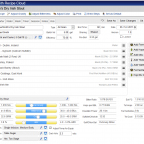 This week I wanted to share a more detailed look at the upcoming Web based version of BeerSmith which is scheduled for release in June of 2021. It will be available to all Gold+ license holders of BeerSmith 3. When released, you can simply log into your existing BeerSmithRecipes.com account and edit recipes in your […]
This week I wanted to share a more detailed look at the upcoming Web based version of BeerSmith which is scheduled for release in June of 2021. It will be available to all Gold+ license holders of BeerSmith 3. When released, you can simply log into your existing BeerSmithRecipes.com account and edit recipes in your […]  This week I cover mead making fermentation and finishing. Last week in part 1, I provided an overview of mead making and the first steps of making the must, pitching your yeast and adding nutrients. This week I will cover the remaining steps. As I covered last week the key components of modern mead making […]
This week I cover mead making fermentation and finishing. Last week in part 1, I provided an overview of mead making and the first steps of making the must, pitching your yeast and adding nutrients. This week I will cover the remaining steps. As I covered last week the key components of modern mead making […]  This week I take a look at the fundamentals of modern mead making, including staggered mead nutrients, degassing and finishing a mead. Modern Mead Making I started making mead a few years back, and it has been an enjoyable addition to my beer brewing hobby. Most home brewers have the equipment for mead making with […]
This week I take a look at the fundamentals of modern mead making, including staggered mead nutrients, degassing and finishing a mead. Modern Mead Making I started making mead a few years back, and it has been an enjoyable addition to my beer brewing hobby. Most home brewers have the equipment for mead making with […]  I’m happy to announce the BeerSmith Mobile 3.1.9 update has been released for Android, iPhone/IOS and the Amazon app store. The app is being released on an “rolling” basis to existing users or via the app store over the next week. More Value, Costs Less The new BeerSmith Mobile release is a significant improvement over […]
I’m happy to announce the BeerSmith Mobile 3.1.9 update has been released for Android, iPhone/IOS and the Amazon app store. The app is being released on an “rolling” basis to existing users or via the app store over the next week. More Value, Costs Less The new BeerSmith Mobile release is a significant improvement over […]  I’m happy to announce the official release of the BeerSmith 3.1 update. This update includes some significant updates to the BeerSmith data storage model, TILT data import, new brewing features and a large number of bug fixes. This release is also a very important foundational step towards establishing both an online version of BeerSmith and […]
I’m happy to announce the official release of the BeerSmith 3.1 update. This update includes some significant updates to the BeerSmith data storage model, TILT data import, new brewing features and a large number of bug fixes. This release is also a very important foundational step towards establishing both an online version of BeerSmith and […]  Buy BeerSmith 3 Download BeerSmith 3 Here is a summary of the new features coming in the BeerSmith 3.1 desktop update. I have posted the open beta version on the main download page at BeerSmith.com, and plan to publish the formal release in the next week or two. You can find additional details for all […]
Buy BeerSmith 3 Download BeerSmith 3 Here is a summary of the new features coming in the BeerSmith 3.1 desktop update. I have posted the open beta version on the main download page at BeerSmith.com, and plan to publish the formal release in the next week or two. You can find additional details for all […]  Steve Piatz, the author of “The Complete Guide to Making Mead” joins me this week to discuss mead making techniques. Subscribe on iTunes to Audio version or Video version or Spotify or Google Play Download the MP3 File– Right Click and Save As to download this mp3 file. Your browser does not support the audio […]
Steve Piatz, the author of “The Complete Guide to Making Mead” joins me this week to discuss mead making techniques. Subscribe on iTunes to Audio version or Video version or Spotify or Google Play Download the MP3 File– Right Click and Save As to download this mp3 file. Your browser does not support the audio […] I was sad to see the tree go, but glad I got to brew a beer with acorns foraged from it before it went!
I inspected each acorn to remove any that were cracked, or otherwise marred. I briefly rinsed them, and then arranged in a single layer on a shallow baking dish in the basement to allow them to dry.
When I visited Scratch Brewing last November (on my drive from St. Louis to Indianapolis for the BYO Boot Camp... next one is March in Asheville) I had the chance to assist Marika on a batch at Scratch, and see their jars of fermenting acorns. Luckily for them, Aaron told me weevils haven't been an issue!
I'm hoping to use the remaining fermented acorns in a small batch at Sapwood Cellars, but the TTB isn't going along with my plans... yet. They've directed me to contact the FDA. It's amazing how many weird chemicals are approved, when a food that people have eaten for thousands of years is not.
Requiem for an Oak
Smell – Even at the higher rate the acorn character doesn’t leap out of the glass. It does have a richer, more woody-fruity aroma than any other quick sour I’ve brewed. I get some of that old book smell mingling with the Munich maltiness. There is also a brighter stonefruit aroma that prevents it from being too heavy.
Appearance – Pretty amber-brown color. Mild haze. Retention of the tan head is OK especially for a sour beer, although nothing remarkable.
Taste – Firm lactic acid, snappy without being overwhelming. The fermented acorns add leathery and fruity depth to the flavor without stepping all over the malt. I’m pretty happy with this as a lower alcohol oud bruin.
Mouthfeel – The flaked rye really helped considering this is a low alcohol sour beer. Doesn’t taste thin or watery.
Drinkability & Notes – For such a unique beer, it is pleasant to drink. The flavors meld nicely and the acorns help to simulate in a way the effect of barrel aging and Brettanomyces.
Changes for Next Time – I’d probably go even more aggressive with the acorn-rate, really to show them off. The beer could be bigger, but more malt might obscure the acorns even more.
Batch Size: 11.00 gal
SRM: 18.0
IBU: 2.0
OG: 1.046
FG: 1.010
ABV: 4.7%
Final pH: 3.43
Brewhouse Efficiency: 72%
Boil Time: 90 mins
Fermentables
-----------------
60.4% - 16.00 lb Briess Pilsen Malt
22.6% - 6.00 lb Weyermann Munich I
11.3% - 3.00 lb Flaked Rye
3.8% - 1.00 lb Castle Special B
1.9% - 0.50 lb Weyermann Carafa Special II
Mash
-------
Mash In - 45 min @ 157F
Hops
-------
1.25 oz - 8 Year Old Willamette (Whole Cone, 1.00 % AA) @ 85 minutes
Water
--------
11 g Calcium Chloride @ Mash
Calcium | Chloride | Sulfate | Sodium | Magnesium | Carbonate |
100 | 110 | 50 | 15 | 10 | 90 |
Other
-------
1 Whirlfloc Tablet @ 5 mins
2 Cup Fermented Acorns @ Fermenter
Yeast
-------
East Coast Yeast Flemish Ale
East Coast Yeast Oud Brune
Notes
-------
9/29/17 Harvested five pints of acorns from the White Oak in my front yard. Allowed to dry open in the basement.
10/6/17 4 larvae of an acorn weevil hatched. Tossed any acorns with exit holes, and tried to identify all of those with small entry holes to toss. Moved remaining acorns to one-pint mason jars, attached lids, and returned to the barrel room for fermentation.
Brewed 7/9/18
7/29/18 Added 1 cup of acorns (split and in a mesh tube with marbles) to the Oud Bruin half.
8/18/18 Added another cup of acorns, loose, as the flavor wasn't there yet.
8/28/18 Racked Flemish half to secondary in glass.
9/9/18 Kegged acorn half.
When it comes to cleaning and sanitizing though, we've had to relearn the entire process. You really can't fill a fermentor with 360 gallon of Oxiclean Free and soak overnight or swirl and scrub... I miss those days. First, let's talk about chemicals and what they do. Our main supplier is AFCO, but Berko, Five-Star, and Loeffler all have fans. Prices seemed similar, we just didn't think about ordering until a couple weeks before we started brewing and picked the one with the quickest turnaround time. We buy most of the chemicals in 5 gallon jugs, and pump them into beakers to measure and dose.
Chemicals
Caustic (5229 Caustic) - Caustic is the primary cleaner used by most breweries. Usually sodium hydroxide based and heavily alkaline. It is ideal for breaking down and removing organic deposits (e.g., krausen rings). You can do a bit of trading-off between time, temperature, pressure, and concentration. That said, 2-3% caustic at ~150F (66C) for 20-30 minutes through the sprayball has been a pretty good place to start for us. Caustic is dangerous because it is capable of breaking down your skin (the lye used in soap making is similar). We started with a powdered caustic (Wash-It), but given the price and efficacy we transitioned to liquid.
Phosphoric-Nitric Acid Blend (5397 Microlex Special 30) - Acid helps to remove inorganic deposits, i.e., beerstone (calcium oxalate). It also helps to neutralize any residual caustic (not that there should be any with adequate rinsing) and to passivate stainless steel. Acid blend is used at similar temperatures and cycle lengths as caustic, although slightly cooler, ~130F (54C).
Five Star Peroxyacetic Acid (PAA) - While there are many sanitizers available, PAA is the most popular for breweries. At the right concentrations it is a robust sanitizer with high effectiveness. It breaks down to acetic acid, so it can be used no-rinse. It is a powerful oxidizer, which makes it important to drain any residual before fermented beer enters a tank or keg. Our bucket was leftover from the old brewery in our space, so we bought a pack of test strips and it still reads the expected concentration after dilution.
Five Star PBW - We have a bucket of this alkaline powered cleaner for soaking hot-side equipment and other gear where we don't want to have to be as careful as we would with caustic. We both used it at home, so were more comfortable with it than the Chlorinated Manual Cleaner we started with.
Iodophor (4330 Spark I2) - Similar to the PBW, it is nice to have a less hazardous sanitizer for spraying ports or soaking fittings. It is only effective on clean surfaces, so it is important to remove of detritus before expecting it to work.
Grain Alcohol - Given its quick kill times and evaporation ethanol is the ideal sanitizer for spray bottles and any surfaces that are highly sensitive (e.g., yeast culturing). Isopropyl alcohol is another option.
General Concepts
Pre-Heating - At this scale a tank has so much thermal mass that you can't simply put 15 gallons (57 L) of hot water to a tank and expect it to still be hot after circulating. As a result if you want the caustic or acid to stay hot, you need to pray hot water into the tank. A tank with an electric element (like our keg washer has) helps too.
Sprayball - Most tanks have a port that leads to a sprayball, a small metal orb that spins and sprays when liquid is forced through. These aren't always perfect, and can have blind spots, especially in ports and above it. In addition, it isn't effective at cleaning its own exterior.
Passivation - This is what makes stainless steel stainless, a thin layer of chromium atoms at the surface that prevents iron from rusting or leeching into the beer (which weakens the equipment and shortens its lifespan). With a pristinely clean surface, the oxygen in the atmosphere is enough to accomplish this, but acids (especially nitric) are more effective.
Safety
These chemicals aren't anything to joke about. Many brewers have scars gained from caustic or acid dripping onto their skin . Safety glasses, long gloves, chemical resistant boots and pants are a must when handling them. Read the safety data sheet for each chemical you are using and know what to do if some gets on your skin or in your eyes. I don't get to drink as much beer as I used to because the end of the day is usually the most dangerous time.
Scott and I prefer to have all of the tank's arms connected from the start, allowing us to use valves to direct the flow of the cleaning and sanitizing solutions. We started off using a manifold coming off the pump, but have changed to daisy-chained T's between the arms. Many brewers prefer to simply move a single output line from the pump between the arms. This requires less setup time, but more active effort once cleaning begins (moving the hose from arm to arm ~10 times through the process). It also carries additional risks if you move the hose without closing a valve.
Our Fermentor CIP Process
1. Once the beer is out of a tank, we turn off the glycol jackets and open the dump valve. We then shoot high-pressure cold water through the sprayball to remove most of the hops/yeast struck to the sides and bottom.
2. We use our on-demand hot water heater to generate 130F (54C) water to spray through the sprayball and manually through a hose to dislodge the bulk of the crud stuck to the sides/top of the fermentor. We'll run it through the pump to get good coverage.
3. We briefly remove the lower fittings on the tanks (including manway, racking arm, thermometer, sample port) to spray out the trub caught in them.
4. We blow compressed air through the sprayball at ~30 PSI with the bottom valve open for 30 minutes. CO2 neutralizes caustic, so best to remove as much as possible before proceeding. This long is likely overkill for a 10 bbl tank, but can't hurt.
5. We assemble our cleaning rig, usually a pump running to the sprayball, with a T to connect it to the racking arm and another to the blow-off.
5. We preheat the tank for a couple minutes by spraying 160F (71C) water in and letting it drain. We hook the water line in right before the pump so we can immediately go to cleaning once it is preheated. Our goal is to get the tank to read ~130F (54C).
6. We then use the hot water heater's built-in meter to send 10-15 gallons of 160F (71C) water into the tank. We dose in 3 oz of caustic per gallon (2.3%) using a stainless steel elbow on one of the ports (chasing the caustic with water to ensure it get in). We then turn the elbow down to allow that port to equalize the pressure inside the tank, while preventing caustic from spitting out.
7. I like to send a little flow through the blow-off and racking arm first to soak them during the 20-25 minutes sprayball at full pressure (60 hz on our pump - or a bit slower if it cavitates). Then five minutes through the other arms, before a final five through the sprayball.
6. Dump the caustic. Rinse each arm with hot water, then burst rinse 10 times for 10 seconds at 130F (54C) through the sprayball, allowing it to drain before each successive rinse. I'll often put 10-15 gallons (38-57 L) into the tank once or twice and recirculate at the end to make sure there is enough pressure to spray all the surfaces. You can check the pH of the drained rinse water to ensure it has returned close normal before proceeding.
2. We then take off all of the fittings (including the sprayball itself), soak them in PBW or caustic. We inspect the fittings and gaskets, rinse and put into a bucket of iodophor. For the ports we spray, scrub and spritz with iodophor before reassembling. We also take the chance to inspect the interior with a flashlight to ensure there are no deposits.
7. We run acid blend at 2 oz per gallon (1.5% by volume) using roughly the same process and times as the caustic. Significantly higher concentrations should be used on new equipment and once a year to ensure adequate passivation.
8. Usually we'll air-dry at this point unless we need the tank the following day. In that case we'll rinse and then sanitize with peroxyacetic acid in cool water at 200 PPM using the same rig, and pressurize the tank to 4 PSI of CO2 to ensure it holds. The next morning we'll dump any residual sanitizer from each port before running wort or beer in.
The whole process including sanitation takes three hours, but most of that time isn't active (just waiting for a purge, or cycle). Going longer on any of the times isn't a big deal, so it is easy to run while working on other things if you keep track of your progress and don't miss a step.
We haven't gotten a CIP cart with dedicated vessels and pump, so our biggest issue currently is that it is difficult for one of us to clean a tank while the other person brews because they require some of the same equipment. Luckily our current schedule of two batches a week doesn't make that too much of an issue.
I am by no means holding this up as a perfect or ideal process. It'll likely be viewed as overkill by some, and inadequate by others. But if you have constructive suggestions, I'd love to hear them! I'd rather err towards overkill because we're dealing with several yeast strains (including killer wine yeast, Saccharomyces cerevisiae var. diastaticus, not to mention Brettanomyces and Pediococcus in a dedicated tank), although we do have the advantage of only dealing with kegs stored cold.
Other Pieces
We addition we'll pump the same chemicals through our heat exchanger and carbonation stone. For the heat exchanger we also heat pasteurize by running 180F (82C) water for 20 minutes inline once we assemble our knock-out rig (we discard the water until we see wort before sending to the fermentor). Our keg cleaner automatically does the same process on our sanke kegs, including air and CO2 purges to recapture the caustic and sanitizer.

